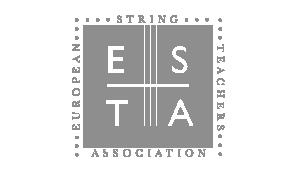Introduction
Many people ask me on Breathing Bow retreats if stage presence is something we can practice, if it is possible to find a way to be exactly where we are - in a concert hall with an audience right here and right now, about to share what we love?
I believe that the answer is yes.
Musicians’ preparation on a concert day can range from taking beta blockers to eating bananas. However, as soon as we are on stage we feel fear. Fear of losing control or mental focus, and above all fear of judgement. Our muscles contract, our heart rate speeds up, we go blank, our bow shakes, we sweat….the list of symptoms for ‘stage fright’ is endless and for many of us, coping with them simply isn’t enough. Why would we want to play music if concerts were merely to be coped with not rejoiced in?
We fight or try to ‘conquer’ the fear. We tell ourselves how foolish we are to feel it (‘There’s nothing to be frightened of!’), or we boost ourselves up with ‘positive’ thoughts - which are in fact just judgements (‘You’re wonderful!’). Or we pretend (‘Imagine the public naked!/ that you are on a beautiful beach/that you are Steven Isserlis!’ ) We practice as much control as possible and cram our minds full of thoughts.
But what if we were to stop fighting and actually listen to the fear?
Marshall Rosenberg, in his work on ‘Non-Violent Communication’, says that all humans share the same fundamental needs, and that every emotion is the expression of either a met (‘positive’ emotions) or an unmet (‘negative’ emotions) need. Through the ‘negative’ emotion of fear we could bring our attention to the unmet needs that we have as performers, a list of which would go something like this:
Stability
Ease
Efficacy
Space
Freedom
Peace.
Security
Connection
Spontaneity
Presence
Expression
Contribution
Most of us, surely, would love to feel all these things during a concert! So, how can we practice them, so that we are fulfilled not just in the practice room but also on stage?
Personally, it is through yoga and meditation that I have been liberated from the prison of fear, finding joy and presence during performance, but there are many other doorways. Alexander Technique, T’ai Chi and Feldenkrais, for example. Whatever discipline we choose, it seems that practicing the following things are key:
1. Power versus strength
Power and flexibility replace strain and effort when we work with core muscles and tension and release in an efficient way.
2. Non-Doing
Becoming comfortable with an alert, relaxed state replaces fear of being ‘out of control’.
3. Presence
Becoming aware of thought in the form of planning, judging, remembering and commenting and how it can take us out of the present moment.
4. Breath
Through breath-work we practice the principles - inspiration and expression, tension and release, taking in and letting go, expansion and contraction - that connect us to music, to life, to ourselves and to one another.
Section One: Power versus strength
‘When you have attained complete relaxation, you are able to be flexible and agile in your movements.’
Zen master Yang Cheng Fu
“To relax is not to collapse, but simply to undo tension….There is nothing to be done. It is not a state of passivity but, on the contrary, of alert watchfulness. It is perhaps the most ‘active’ of our attitudes, going ‘with’ and not ‘against’ our body and feelings.”
- (Vanda Scaravelli - Awakening the Spine.)
Building strength through force only promotes the shortening of muscles as they contract, causing fatigue and strain. That strain goes against rather than with our body. Developing power is another matter entirely. Power is a natural state. It involves movement generated from our core, a great deal of relaxation and a perfect relationship between tension and release.
Moving from our core
Every form of skilled or powerful movement on terra firma illustrates that athletic movement works best when power flows freely through the core. - Terry Laughlin, Total Immersion Swimming
The terms can be vague and we often use them incorrectly. Some speak of muscles, some of bones and others of energy centres, but I think most traditions agree that the area around our centre of gravity is key to all movement. Just as we do not learn to sing but only articulate with our lips, teeth and tongue, we do not initiate sound with our fingers. Moving from the core is not only efficient but it also unites both sides of the body in one gesture, a gesture that comes from our response to the music.
When we walk, we move our centre of gravity forward, throwing ourselves off balance, and the released leg swings forward. The whole body right down to the toes respond to this shift in weight. The swing of the arm round the torso in bowing is no different. Movement happens through release as the feet sitting bones lead the shift of weight from left to right. The arm falls to restore equilibrium and the fingers follow. If the shoulder; elbow or wrist are blocked (so often the case in our obsession with having a straight bow) this swing is destroyed, we lose our power and must resort to strength.
As the body is constantly moving in spirals, with the shift of weight from one side to another comes a slight rotation of the torso. The cello pedagogue, Steve Doane, talks in his ‘Owl’ exercise about sweeping one’s gaze from left to right as one crosses from the A to the C string or shifts up the fingerboard. This works because we do not shift our gaze just with our eyes or even just our head. The movement of the eyes and head originate at our centre, and it is the imperceptible rotation of the torso that causes the ease of movement. Doane says:
“This swing supports the shifting motion by communicating energy from the feet through the hips to the back and arms. It is an essential part of your dynamic cellistic balance.” -‘ - Cello Ergonomics
If we try the string crossing exercise with the opposite core movement - turning from right to left as you cross from A-C strings on the cello - we see how restricted our natural power is.
Tensegrity
Initiating movement from our core does not mean hurling ourselves about. In fact, by making sure the big cogs power the little cogs, movement becomes more efficient. A gesture takes time to flow from the core through to our limbs, and as one movement is being completed, so another is being prepared, causing a healthy tension. This tension is called tensegrity.
Tens(ion) plus (int)egrity.
“Tensegrity is a structural principal of geometry where shapes benefit from strength and flexibility due to the push and pull of their parts.” - Will Nagel of tensegritymovement
Obviously, we need muscle tone (tension) to move. We need it to sit on a chair, and certainly to play an instrument, but we also need release. Life and music are a constant play between tension and release. The push and pull of a wave, a dominant chord resolving to the tonic, the in and the out-breath, the up and the down bow all express this perfect relationship.
Section Two : Non-doing
The tennis player observes the ball as it leaves his racket and completes the trajectory he has sent it on. He is no longer ‘in control’ of the ball but rather relaxed, alert and watchful. Primed for the return. Once we have learned to initiate movement from our core, we must then practice not interfering in it. For those of us who have learned that playing is all about control, holding and doing, this is quite a challenge, and yet this is what allows us to replace fear of being out of control with freedom and ease.
Gravity
“When the abandonment to gravity comes into action, resistance ceases, fear vanishes, order is regained, nature starts again to function in its natural rhythm and the body is able to blossom fully, allowing the river of life to flow freely through all parts.”
Awakening the spine…Vanda Scaravelli
It takes strength to hold a bow-arm from the string, and with added adrenalin this becomes even more challenging. Fearful of dropping it or crashing onto the string we grip the bow harder and migrate to the tip to escape the arm-weight we cannot control. That’s a lot of doing for a small sound! Practicing in a way that works with, rather than against gravity, we reorganize rather than withhold the weight. In forte, for example, the arm is aligned so that there are as few kinks as possible and the weight flows freely into the string. In pianissimo the elbow is low and the weight, unable to travel up the hill of the forearm just as water does not travel up a U-bend, rests at the elbow. All dynamic nuances (plus their corresponding vibrato width in the left hand) arise from the natural play between these two attitudes of tension and release, best illustrated in the action of bouncing a ball.
The Still Point
…Except for the point, there would be no dance, and there is only the dance. - TS Eliot
At the end of the out-breath there is a still point. A point of non-doing, of rest and relaxation. It is also a point of regeneration. T.S Eliot calls it ‘the still point of the turning world’. There is such a point in the arc of the bow, in each note, gesture and phrase. When a gesture is complete, and a note comes to a natural end (with the elbow down and wrist up in complete release) we have arrived there. For many it is a scary place, one we either flee on a regular basis or do not even know exists, but it is one I highly recommend making friends with and hanging out in! Complete relaxation of body and mind come, of course, only at the end of a piece of music, but there are degrees, and becoming familiar and comfortable with this still point means we can sail close to it whenever we need, continually regenerating ourselves and the musical line.
Practicing non-doing
To change our relationship to doing we need to learn to trust in the wisdom of our body more than the wisdom of our mind. This takes practice. Rather than trying to make the length of a note fit our idea, we practice allowing our note to be just as it is, in direct proportion to and a consequence of the preparation we make. We develop a kind of honesty by not interfering with it, and if we want it to be different, we go back to the preparation. (That is when we draw in the wisdom of our mind). If we work, first with one, then a series of notes, then an entire phrase in this way, eventually we are able to ‘generate’ a whole movement. Unencumbered by detail, we are driven rhythmically and harmonically, rather than by individual notes, entering into relationship with rather than controlling the music.
Section Three: Presence
The mind in its natural state can be compared to the sky, covered by layers of cloud which hide its true nature. – Kalu Rinpoche
Once we learn to generate movement from our core and not interfere with it, once we start to follow rather than control the music, we experience an extraordinary new space.
Presence.
Like a city dweller suddenly finding herself under a huge desert sky, for some this space can be terrifying.
What do I put in it?
Who am I in it?
In fact, it is there we find connection. With ourselves, the music and the audience.
Thought
“In order to really be, you have to be free from the thinking…”
“Non-thinking is an art and, like any art, it requires patience and practice.”
-Thich Nhat Hanh (Silence: The Power of Quiet in a World Full of Noise)
Thought is necessary. We need to think during our practice - about the composer’s life, the harmony, the metre, the structure. We need to observe how we are playing our instrument and how it corresponds, or not, to what we hear in our inner ear. But thought in the form of planning, judging, remembering and commenting takes us out of the present moment and when we are thinking in this way, clear observation is impossible.
Here is an example of a ‘thought’ during practice, which is in fact a judgement, followed by a clear observation.
Judgement: ‘Out of tune!’
Observation: The note was flat, which means I did not prepare the shift enough. My elbow needs to bounce higher so the forearm falls further.
‘Thoughts’ we have during concerts can be even more harsh: ‘You have no right to be on stage!’ ‘Your teacher will be disappointed!’ But they can also be ‘positive’: ‘Think about releasing your thumb on the G’. ‘Go to the B flat’. ‘Good. Must remember that for next time’. ‘Relax’. ‘Try to be present’.
Every one of these thoughts does the same thing. It takes us out of the present, even the one that asks us to be in it. Because a concert takes place in the present moment, I believe that fifteen minutes’ meditation a day can be far more helpful than four hours’ thinking which we call ‘instrumental practice’. I also believe that if our practice could be composed of clear observation, listening, both leading and following and respecting the natural movement of our body, we would have to do very little of it.
Getting ourselves out of the way
As musicians we fear that, unless we inject every phrase with our ‘personality’, our playing will be boring. Unless we do things to the music we won’t have an ‘interpretation’. However, when a musical line falls like an autumn leaf, or rises like an eagle soaring on a thermal, is this our personality? Or our interpretation? When we are able to get ourselves out of the way, there is no ‘I’ to judge or be judged. Because there is no judgement there is no duality, no perfection, no imperfection, no right, no wrong, no them (the audience) and us (the performer). There is only a magical moment-to-moment unfolding.
Section Four: The Breath
"The bow must be a living thing at all times, and all living things need to breathe" - Steven Isserlis, cellist.
For me, the breath is the thing that binds all of this together. No-wonder it is at the root of so many spiritual practices! It is inspiration and expression, tension and release, taking in and letting go, expansion and contraction. It is not ‘ours’ though it passes through us, and it connects us with ourselves, our bodies and the audience. With all living things. The ocean breathes, trees breathe….It is everything we are and everything music is. When we are aligned and in harmony, we feel as if we are being breathed, just as we can, in performance, feel like the music is playing us. Working with the breath makes and builds these vital connections.
BB Exercise One. The arms’ response to the breath.
Finding the seeds of movement in bowing.
Stand comfortably with your arms hanging loosely by your side. Breathe slowly and deeply, being aware of the breath filling and emptying the front, sides and back of the rib cage. Bring your awareness to your arms and observe any response they may have to the expansion and contraction. If you feel the movement, amplify it, allowing the arms to float up and away from the torso on the inhalation, and fall back on the exhalation. You may also observe a slight rotation in the arms as you breathe in and out.
BB Exercise Two. Cello Wings
Opening the arms out like wings on the inhalation and folding back on the exhalation.
(NB. This exercise is unnatural in one way as we almost never prepare to play with an exhalation.)
Start at the heel at the bottom of an exhale. As you inhale and fill the rib cage, allow the breath to lead your arm as it opens out like a wing in response to the expanding rib cage. At the tip of the bow, pause and enjoy the tension of the full rib cage. Allow the exhale to lead your arm in folding back towards your body on the return to the heel. Notice the tension as the arms open and the release as they fall back with gravity and amplify this. The down bow will become slower and deeper, and the up bow faster and lighter.
BB Exercise Three. The Curved Bow
Using the breath to find the curve of the note and the bow.
Inhale to prepare. Start at the heel with a full rib cage. Exhale for three counts on the down bow and allow the bow to move in response to the release, coming to rest at the end of the out breath (probably somewhere near the balance point). Then inhale for three counts as your arms open away from your body, and your bow to moves towards the point. Let the following exhale lead your bow change, so you exhale for three counts on the up-bow, coming to rest again near the middle, and inhaling for another three counts as you move towards the heel. Always let the breath lead the movement. Observe the difference in bow speed and contact point as you gather and lose momentum.
Variations
Finding the breath in the rhythmic pattern.
How we choose to practice depends on the music we are playing. For example: If we are playing a piece in three (the slow movement of Dvorak concerto for example) it is helpful to practice breathing out for two counts, coming to rest, then breathing in for one on both down and up bows. This corresponds to the minim and crotchet rhythm. If we are playing a passage in 4, we may look to see where the impulse, the resting place and the preparation are in the musical shape (after the three if it is a dotted minim and a crotchet or after the two if it is two minims).
BB Exercise Four. Vibrato
Using the breath to link up the right and the left sides of the body.
Do the exercises above on a scale and allow the left arm to release and come to rest by your side exactly as the bow arm does on the exhalation. Then, on the inhalation allow the arm to open out (always following the expansion of the rib cage) and notice how the width and intensity of the vibrato naturally mirrors the bow speed.
Breath is the bridge which connects life to consciousness, which unites your body to your thoughts. – Thich Nhat Hanh
My teacher, Timothy Eddy, once said to me ‘Ruth, something inside you has to move before you are moved to play.’ In a world where so much is taken at face value, from the outside - in, the breath is a vital teacher, reminding us to be embodied, to live and play from the inside-out.
Many people ask me on Breathing Bow retreats if stage presence is something we can practice, if it is possible to find a way to be exactly where we are - in a concert hall with an audience right here and right now, about to share what we love?
I believe that the answer is yes.





